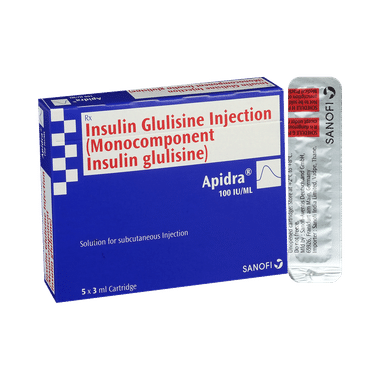

Insulin Glulisine (100IU)
Apidra 100IU Cartridge (3ml Each) is normally prescribed along with a long-acting type of insulin or other diabetes medicines. Your doctor or nurse will teach you the correct way of injecting it under the skin. It should be taken 15 minutes before a meal or within 20 minutes after starting a meal. Do not stop taking it unless your doctor tells you to. It is only part of a treatment program that should also include a healthy diet, regular exercise, and weight reduction as advised by your doctor.Check your blood sugar levels regularly, keep track of your results and share them with your doctor. This is very important to work out the correct dose of the medicine for you.The most common side effects of this medicine include hypoglycemia, allergic reactions, injection site reactions, lipodystrophy, itching, rash, and upper respiratory tract infections. To prevent these, it is important to always inject the correct dose of medicine, have regular meals (do not skip), and monitor your blood sugar levels regularly.Do not use this medicine when you have low blood sugar levels (hypoglycemia). Tell your doctor if you have ever had kidney, liver, or heart problems before starting treatment. Pregnant or breastfeeding women should consult their doctor before using it.
Most side effects do not require any medical attention and disappear as your body adjusts to the medicine. Consult your doctor if they persist or if you’re worried about themCommon side effects of Apidra
1 Solution for Injection
Image shown is a representation and may slightly vary from the actual product. Every effort is made to maintain accuracy of all information displayed.
Your doctor or nurse will guide you how to use this medicine.
Apidra 100IU Cartridge (3ml Each) is fast-acting insulin which starts working within 10-20 minutes after injecting. It works similar to the insulin produced by the body. Insulin facilitates reuptake of glucose in muscle and fat cells and also blocks the release of glucose from the liver.
Related Warnings
It is unsafe to consume alcohol with Apidra 100IU Cartridge (3ml Each).
Apidra 100IU Cartridge (3ml Each) is generally considered safe to use during pregnancy. Animal studies have shown low or no adverse effects to the developing baby; however, there are limited human studies.
Information regarding the use of Apidra 100IU Cartridge (3ml Each) during breastfeeding is not available. Please consult your doctor.
Your ability to drive may be affected if your blood sugar is too low or too high. Do not drive if these symptoms occur.
Apidra 100IU Cartridge (3ml Each) should be used with caution in patients with kidney disease. Dose adjustment of Apidra 100IU Cartridge (3ml Each) may be needed. Please consult your doctor.
Regular monitoring of blood glucose levels is recommended for dose adjustment.
Apidra 100IU Cartridge (3ml Each) should be used with caution in patients with liver disease. Dose adjustment of Apidra 100IU Cartridge (3ml Each) may be needed. Please consult your doctor.
Frequent and regular monitoring of blood glucose levels is advised.
You have to be extra careful if you are planning to take both pioglitazone and Apidra 100IU Cartridge (3ml Each). Consult your doctor first before taking any other medicine. The doctor will suggest if you can safely take Apidra with pioglitazone and if you would need regular follow-up. This is because Pioglitazone can cause fluid retention in your body, especially when used in combination with insulin. You may develop symptoms of heart failure like edema, swelling of hands and feet, weight gain, breathlessness, etc. Also if you already have heart failure, it may get aggravated.
It is correct that you should not use the same spot again, as it can cause changes in the fatty tissue just under the skin. It can either cause lipodystrophy or lipohypertrophy. Lipodystrophy means abnormal changes in the distribution of body fat. It includes lipohypertrophy (thickening of adipose tissue) and lipoatrophy (thinning of adipose tissue), and may affect insulin absorption. Rotate insulin injection or infusion sites within the same region to reduce the risk of lipodystrophy.
Apidra 100IU Cartridge (3ml Each) contains a fast-acting insulin. Injecting Apidra into a muscle would make its absorption even more rapid. As a result, the chance of having a serious episode of hypoglycemia or low blood sugar would increase. Therefore, you should inject the insulin just beneath the skin by pinching up some skin and fat.
Yes, you need to be careful because symptoms of low blood sugar (hypoglycemia) like increased heart rate may not be noticed by you. Keep a regular check on your blood sugar and consult your doctor if the problem persists.
It depends on whether you have type I diabetes mellitus (body does not produce insulin) or type II (body does not respond to insulin). For patients with type I external source of insulin is the only treatment available which cannot be stopped, as your body does not produce sufficient insulin. But for patients with type II diabetes mellitus, the doctor may stop Apidra if your blood sugar levels are well controlled with exercise, healthy diet and other diabetes pills. However, do not stop taking it on your own without consulting your doctor as it may worsen your condition.
Yes, Apidra 100IU Cartridge (3ml Each) can cause hypoglycemia (low blood sugar levels). Symptoms of hypoglycemia include nausea, headache, irritability, hunger, sweating, dizziness, fast heart rate and feeling anxious or shaky. It happens more often if you miss or delay your food, drink alcohol, over-exercise or take other antidiabetic medicine along with it. So, regular monitoring of the blood sugar level is important. Always carry some sugary candies, glucose, glucon-D or fruit juice with you.
Apidra 100IU Cartridge (3ml Each) belongs to the class of antidiabetic medications. It is a man-made version of insulin which is prescribed in diabetic adults and children of age 1 year and above. This medicine is used to help improve blood sugar levels and glycemic control.